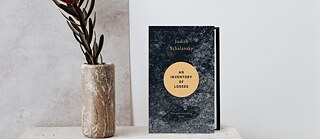Judith Schalansky
An Inventory of Losses

What happens when something is lost to the world? With whatever traces left behind, can one retrace the lost object? What will remain when things are lost? These are some questions Judith Schalansky’s insightfully astute book An Inventory of Losses attempts to tackle.
By Prathap Nair
A Wunderkammer of a dozen things lost to the world!
While it may be physically impossible to keep a tab on things we lost to the passing of time, unfortunate accidents and perhaps also to collective human selfishness so far, Schalansky’s book rustles up a list of twelve things. Circumnavigating the world in twelve chapters from the remoteness of the north-eastern Pacific Ocean to the forests around Greifswald in Germany, Man International Booker longlisted (2021) book looks longingly at things lost to the world and reimagines them into existence.Schalansky’s Inventory of Losses unspools in twelve, hard-to-categorize eclectic essays and fall anywhere in the spectrum of nature writing, musings over the impermanence of things and meditative contemplation of lost artefacts. Some are delightfully rendered short fiction pieces – Schalansky’s interpretation of the subjects – while others are retelling of history. But all of them are keenly observed, exquisitely detailed and often elegiac.
An eclectic collection of genre-bending essays reimagines things that are lost to the world.”
Prathap Nair on the book "An Inventory of Losses"
Translated from German by Jackie Smith in razor-sharp prose, the book is also a beautifully produced object with a gold embossed cover page with a strikingly grainy canvas as background. The admirable production quality of the book is thanks to Schalansky herself, who is a book designer. Essays, each a precise sixteen pages long, are separated by dark grey bookmark pages featuring images discussed in the book.
A Cabinet of Curiosities
One review called it the cabinet of curiosities, evoking the German word Wunderkammer - a mostly untranslatable word that necessarily means a menagerie of uncategorisable things. These include, but not limited to, the Southern Cook Islands (Tuanaki), the Caspian Tiger, Guericke’s Unicorn, the love songs of Sappho, the Seven Books of Mani, and Palace of the Republic. The chronicles span from a geographical loss (the islands) to the extinction of species (the tiger) to literary curiosities (the songs of Sappho), even films (the boy in blue) and architectural loss (Villa Sacchetti, Palace of the Republic).To condense the world’s curiosities into twelve chapters is undoubtedly a limitation for Schalansky who lists down in its preamble a two-page compendium of things either lost or discovered while she was working on the book, whetting the reader’s appetite. “…the Cassini spacecraft burned up in Saturn’s atmosphere, the Schiaparelli Mars lander crashed in the rust-coloured rocky landscape of the planet it was supposed to be exploring; a Boeing 777 disappeared without a trace en route from KL to Beijing.’ There are also things that are found: ‘…in the Cygnus constellation, 1,400 light years from our sun, a celestial body was found, in a so-called habitable zone..’
From the Islands swallowed by the sea to a lost silent film
In the first chapter, we are introduced to the Tuanaki islands, which disappeared in an earthquake in 1842 but continued to occupy a spot in maps for another three decades, till 1875. Parsing details from the “one and only report,” about the island, the piece evocatively conjures up images of Tuanaki. “...I imagined, there was nothing in the place where the island had been but dead trees floating on the glassy surface of the ocean,” she writes envisioning how the sea where the island once stood must have appeared the day after the quake.The book’s tenor changes according to the subject dealt with, but it comes alive when the writing involves nature. In the piece titled The Greifswald Harbour, the prose brings to life a lost painting. Caspar David Friedrich, the German artist, painted the harbour of his hometown, also Schalansky’s, in 1820 - an artwork that was destroyed in a fire in 1931, essentially leaving no trace of how it even looked.
In the essay, Schalansky takes a hike along the harbour and vividly describes the flora and fauna evoking the painting: “Filtered light falls on the slender shoots of hazel, the young beeches and slim birches. Before long tall spruces cast deep shade on the ground, which is springy now, and strewn with scaly pine cones and yellowed needles…” The painting is lost to the world but if it’s easy to imagine its expressionist pastoral landscape with the help of Schalanksy’s words.
A Hollywood star, reimagined.
In the piece called The Boy in Blue about Friedrich Wilhelm Murnau’s lost silent film, Greta Garbo is reimagined as a fretful star of yesteryears. “The lengths she’d gone to for this face. Had her hairline straightened, her teeth fixed, her hairstyle and hair colour changed. No wonder the bastards imagined it belonged to them.”Ranging from nature writing to magical realism, the book inventively covers vast ground using past as a canvas to illuminate the present. As she writes in her preface: “This book, like all others, springs from the desire to have something survive, to bring the past into the present, to call to mind the forgotten, to give voice to the silenced and to mourn the lost.” While she admits writing cannot bring anything back, Schalansky firmly believes it is the only way to experience everything. Therein lies the importance of reading this book.
About the Author
